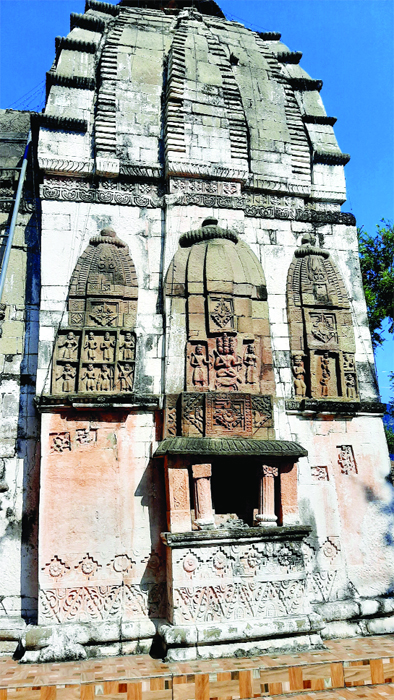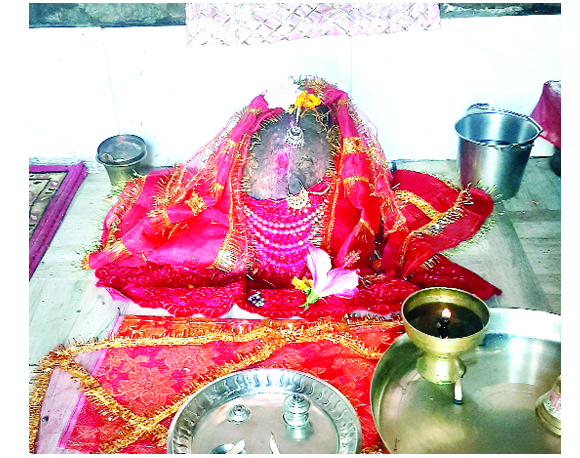K. Kumar
An architectural marvel remains inaccessible
Jalandara Devi Temple, a state protected monument, located at village Ladden Kotli at about 10 kms from Udhampur town not only sears medieval cultural vibrancy but also depicts architectural marvel of tenth century AD. Built probably by King Jalandhra of Trigarta according to folklore, Jalandara Devi Temple, near Laddan Power Station on the left bank of the Udhampur Tawi is a unique example of the blend between Margi and Desi traditions.
 This temple is constructed with sandstones in Nagara style, a typical North Indian architectural style where the ‘Shikhara’ remains most prominent element of the temple and the gateway is usually modest or even absent.
This temple is constructed with sandstones in Nagara style, a typical North Indian architectural style where the ‘Shikhara’ remains most prominent element of the temple and the gateway is usually modest or even absent.
About one hundred and fifty figures carved in stones that of gods and goddesses besides wrestlers, animals, birds and guards remind one of Khajuraho style of stone carvings that are visible on all four sides of this magnificent temple.
There are no boundaries marked in this type of Nagara style construction and the pedestal on which this temple has been built is higher than ground.
This temple is situated next to the remains of a fort. Some remains of the fort can be seen from the temple site.
The delicate but rich stone carvings of the temple reflect the temple building processes of that era in the Jammu region. Most of the stones used in this temple match the group of Krimchi temples built by the Pandavas during their period of exile.
The four walls of the temple meet at the top in a spire on which rests a round stone plate which has been restored with the help of steel rods after damage.
There are nine small shrines carved on the front of the temple followed by two shrines each on the walls on either side of the main entrance. Three temples each are carved on the remaining three walls, taking the total number of temples carved on stone on the four faces to twenty one. The peak is not well preserved.
It is believed that Mata Jalandara is the family deity of the Chenani kings and the temple might have been built by the earlier Chenani kings. The need for building the fort was probably felt by the later kings. The carvings and designs in semi-folk style on all sides of the temple indicate that the construction was done by local artisans.
There are three carved faces on the front wall of the temple which are believed to be of the Sun God. Below that is a small carved stone shrine with an urn on top and a statue below.
There are pillars at the entrance on which dvarapalas (protectors) are carved. The main entrance is approximately 1.50 meters wide and 0.75 meters high. The entrance is also decorated with flowers carved on stones. Statues of Ganga and Yamuna are also visible at the entrance alone. The Pindi of the Goddess is situated just in front of the sanctum sanctorum which is slightly raised above the floor. Inside the temple, an idol of the goddess can also be seen on the front wall which is light black in colour.
This idol of the goddess has four arms and is shown sitting on a lion which is standing on oxen. It is believed that this type of statue or idol is not the work of Dogra artisans but of the artisans of Himachal Pradesh.
According to Padma Shri awardee Prof. Shiv Nirmohi, who has done extensive research on this temple, there is also a lamp lighting area in the sanctum sanctorum which shows that the provision for lighting the temple during evening hours was deliberately kept.
When seen from inside the small threshold, the heads of eleven snakes are carved, while the voices of fourteen snakes are carved on the larger threshold. This yantra is considered a symbol of eleventh Rudra and fourteen penances. One of the walls of the temple is also believed to have a powerful tree shaking statue of Bhimsen which is quite admirable.
Apart from Krishna Leela, Lord Brahma, Lord Indra, Sugreva, Apsaras and some other characters of Ramayana are carved on the walls of this temple which reflect the cultural philosophy of that era.
Jalandara Devi Temple, a state protected monument located in the Laddan Kotli area, has no proper road leading to the village where this historic temple is located.
Secondly, in the absence of a proper approach from the main road, it is practically not possible for visitors to reach the temple site, which is situated on a small hill overlooking the Tawi river.
For the disabled, it is an established inaccessible site with no path, water or waiting area available to the temple or to the protected declared monument site. Another disappointing feature of this site is that despite being protected by the state, the local people are unaware of its architectural values and are making interventions and modifications to the temple and its surrounding area as per their convenience, thereby destroying the original structures. The damage is being done.
There are a few houses around the poorly maintained Jalandara Devi temple whose residents offer prayers there, perform daily bhajan-kirtans and even take care of the temple grounds besides organizing the annual bhandara.
A local resident Pream Nath said that water works department staff and locals keep the affairs of the temple running.
Tourists do not come here because this place is inaccessible.
A social worker Som Raj Atri said, “Had the Jalandara Devi temple been restored to its glory and provided access by building a road or path, the site would have shone on the tourism map of major medieval temples located across the country as an architectural marvel of that era”. The only temporary route to reach the site is so rugged and dilapidated that the climb becomes really difficult for tourists or pilgrims, especially the elderly, the disabled, women and even children.
Trending Now
E-Paper


